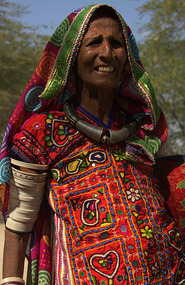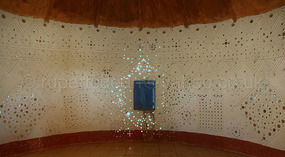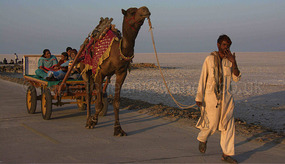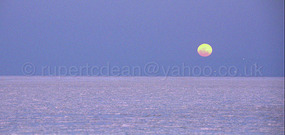Back in the Gangaram Hotel, Ishtar had not only organised the car for my trip to the Great Rann to see the Blue Moon Festival, but also found me two Swedes to split the cost. Both were India Veterans and the lady was a handicraft expert. That evening we also me a couple from Brighton, Will & Natty who also joined our little group. We did have issues with the car owner as as more people joined the group the total price (strangely) increased! “This is not unique” he protested. After a mostly unsatisfactory discussion we settled on a fee that ensued the owner benefited just GBP 12 from the extra passengers not the preferred GBP 22. Incredible India!
We meet the following morning at ten to start
. Finally I thought, almost one month late after getting the December date wrong, I was finally going to see this ‘Blue Moon’. The car was actually new and luxurious, and we started off at the equally luxurious tourist office to get our Tourist Tax Certificates (sorry I mean permits). Once procured we started off north.
With handicrafts a shared passion we selected a few villages to see including Sumeraser Sheikh (where I had been with Kishor on my rickshaw travels), Bhirendiara, Khavda and Hodka. Actually this detour turned out to be a huge disappointment. The crafts I saw with Kishor were immensely better and far more diverse (in my opinion) than what we saw on the way to the Rann. Most of what we were continually shown was the standard tourist fare, in each village. The only exception was the NGO Kala Raksha when we visited their HQ in Sumeraser Sheikh. I had visited this NGO in the Ilark Hotel in Bhuj with Kim and was unimpressed, but here at HQ their work was magnificent with magnificent prices to match. I was particularly impressed by two silk shawls at GBP 200 a pop and a beautiful woollen shawl at GBP 600. The work was fine, but at those prices I was not in the market.
As sunset approached the driver made his way to Dhordo and the gateway of the Rann (the salt flats). Here the festival had spawned a permanent tented village with a huge array of shops and accommodation. This is the festival that Prime Minister Modi had started and promoted and was a huge cash in on the ‘blue moon’ - the full moon over the salt lakes
. The army was there (of course) collecting more additional tourist taxes. Actually the whole facility was somewhat underwhelming, creating a degree of artificiality that neither the superior Bolivian and Ethiopia salt flats have. After a few minutes amongst this mayhem I would not have been surprised to have encountered a Starbucks or even a Walmart on the salt’s edge.
After completing the additional taxation formalities and (useless) paperwork yet again, we were allowed on the causeway that snaked its way onto the salt flats some eighty kilometres from the Pakistani border. Here there were hoards of Indian tourist, traders offering tourists camel rides, professional Sadhus, dancers and other paraphernalia.
Once you get past this melee of tourist stuff, the flats themselves are most certainly picturesque. They are not hexagonal ridged like in Bolivia or symmetrically flat like the one in Ethiopia. These are patterned and were strangely soggy. Odd since there had been no rain for many months
. The other blessing was that there was very little litter and other rubbish. That made a refreshing change. However to get somewhere on the flats where I would be on my own involved a good thirty minute trek along the causeway and then onto the flats themselves. By now as the sun was setting fast, so this became a race against time.
By the time I was almost on my own, the scene was breathtaking again. Flat and remarkably featureless, the salt stretched to meet the horizon and the sun was now a huge ball of red. It slowly dropped below the horizon and left a erie light blue glow in the sky. I awaited the moon.
Unfortunately I was now spotted by a group of domestic tourists, who despite the camouflage my hat provided, had worked out I was a foreigner and came running over. “Which country? Whats your name? Can we have a photo?” was the chorus. My tripod was nudged off its carefully balanced position and my camera knocked. I started to get angry, just as the bright yellow moon arrived on the horizon
.
A similar experience had befallen me in 2013 with a perfect view of a Rhino in Kaziranga National Park, and it would seem nothing would deter these people. By the time I had got rid of them the moon was in a good position, not blue but certainly very beautiful and the light was diminishing fast. I tried to correct the problems caused, but without enough light and no torch this was futile and my pictures were a big disappointment. More tourists then arrived to hassle me.
Surprisingly through out this fraught experience the moon or the background never went the blue I had seen on the internet photographs other foreigners had captured. A light blue and grey blue was all that was managed. Yet this was captivating - when I was alone.
We all got back to the Gangaram that night, exhausted. The next morning the Swedes left and I met Kishor as arranged. I wanted to complete my handicraft village odyssey and, especially after the lacklustre crafts of the previous day, was pleased to see Kishor. He was happy to see me and we left straight away for Bhujodi
.
I had been a little disappointed not to see any of the Bhujodi craftsman on my fist visit with Kishor and was keen to change this. I don’t know why the first visit last month to this village had been a disappointment, but I am learning that in India, sometimes its best not to concern oneself with these issues. This time we entered a different part of the town and suddenly found ourselves in a handicraft street. Each house specialised in a certain craft, mostly in weaving. the scene was truly colourful as these crafts people had hung their wares outside their homes illuminating what was a drab traditional farming street. It was a strange sight seeing cows wandering past huge collections of brightly coloured embroidery.
Firstly Kishor took me to the house of Ramiben Vanka Rabari who sells antiques from Kutch. He was similar to Salim Wazir, although he had a much smaller, less prestigious collection and his prices were quite a lot less (camel belts were 70% cheaper). Everything he showed me was interesting, some including the Ragon work which was old and startling. However it was just too big to be of any use. I did buy a 67 year old piece of embroidery made with copper which was beautiful and unusual.
Next up we entered a huge sort of cooperative market, showcasing artists from all over Kutch. I was keen to visit this place to track down Babu Bhai. Babu is one of the last three remaining Mashru weavers in the Kutch region. Mashru weaving is a complex type of weaving, using both silk and cotton. The inside of the woven cloth is cotton, while the outside is silk. Apparently it originates from Persia, where Muslim communities believed that silk should not touch a person's skin. Unfortunately we had a rather fruitless search for this Mashru Artist and soon established that he had returned to his village of Don near Mandvi. Next time I thought. I did though meet two separate men selling pen knifes they had made in Anjar, a town renowned for pen knives and nut cracker makers located some 50 kms west. Luckily these were not as interesting as I had hoped, so that saved me a journey.
Back into Bhujodi and we stopped at the house of Mr Shamji Bhai. He was recommended by Kim whom I met in December and turned out to have some of the most exquisite shawls I have seen, with prices to match. He used imported wool, from Austria (“Kutch wool is too harsh” he exclaimed) and he also employs four weavers out of the back of his family home. His work (to my untrained eye) was memorable. Fabulously detailed and fine, prices from GBP 100-10,000 for the shawls. Shamji was kind enough to spend time with me and show me his work rooms.
Next up was Narayanbhai Seju. He and his family are part of the Kala Raksha brand and make their rugs for them whilst also exporting to Finland. These are made from organic wool and traditionally dyed with natural colours and are woven by Narayanbhai and his son. At GBP 25-30 I thought they were a steal. The family were passionate and dedicated and they offered to freight to the UK. This immediately appealed and I have decided to get some when I am back in UK and settled. They were lovely people and keen to point out its a family business and they will not comprise their principles or expand.
It was difficult to see how this experience could be topped so we had a quick roadside chai and left for another NGO. This was a disappointment, so I decided that was enough and we returned as planned to the Khatri family in Paddhar, so I could buy some of his block printing. I visited the Khatri’s in December and this time just arrived to buy. When I entered though I was pleasantly surprised to find one of the Japanese girls, Hisae, there. It was nice to see her again and catch up on her news. She also kindly helped me in Mr Khatris rather chaotic shop with his amazing block printing.
That was it and we returned to the Gangaram. I bid farewell to Kishor who has been excellent and started packing. The next morning, I was ready for my 10.00am check out and then helped Ishak with his trip to the post office with my gear for postage.
With all that completed, I decided to accompany Will & Natty to WAMA. WAMA is the women’s artisan NGO in Bhuj run by Smita. We were recommended by the Swedish lady who felt it was some of the finest work she had seen. I also thought this would take my mind off the coming night bus journey (I know another coffin ride - just because I could not get a railway ticket). Our casual stroll to the offices of Wama turned into a marathon trek as we got lost time and time again and nobody we asked seemed to have heard of it. Nevertheless we did manage to find it after four hours and we had a great visit. Some of the work in particular the batik bedspreads, silk tie dying and embroidery cushion covers were spectacular. The prices were OK. However what really caught my eye were the bottle carriers. Embroidery, Mashru and patchwork I felt there maybe a market for them as wine bottle carriers in the UK. Consequently Smita and I had an interesting conversation.
Back at the Gangaram there was just enough time to say goodbye to Ishak, Mr Jiti, Will and Natty and leave to catch my bus.
Blue Moon, Salt Flats, Crafts
Friday, January 02, 2015
 Bhujodi, Gujarat, India
Bhujodi, Gujarat, India
Other Entries
-
78Sarcophagi, Fountains of Blood, Horseback
Sep 2896 days prior Cuispes, Peruphoto_camera3videocam 0comment 0
Cuispes, Peruphoto_camera3videocam 0comment 0 -
79Waterfalls, Rain and Loud Peruvian Pop Music
Sep 2995 days prior Pedro Ruiz, Peruphoto_camera4videocam 0comment 0
Pedro Ruiz, Peruphoto_camera4videocam 0comment 0 -
80Hummingbirds, Orchids, Coffee and Stomach Bugs
Oct 0292 days prior Moyobamba, Peruphoto_camera5videocam 0comment 0
Moyobamba, Peruphoto_camera5videocam 0comment 0 -
81Battlefields, Zulus, 1879, Leaving South Africa
Oct 1876 days prior Dundee, South Africaphoto_camera4videocam 0comment 0
Dundee, South Africaphoto_camera4videocam 0comment 0 -
82Mr India, X Factor Naga style, Exotic Food
Nov 0657 days prior Mokokchung, Indiaphoto_camera5videocam 0comment 0
Mokokchung, Indiaphoto_camera5videocam 0comment 0 -
83Burma, Headhunters, Opium & Dust
Nov 0954 days prior Launghe, Myanmarphoto_camera4videocam 0comment 0
Launghe, Myanmarphoto_camera4videocam 0comment 0 -
84History, bad guesthouses, hills, Wakching
Nov 1449 days prior Mon, Indiaphoto_camera4videocam 0comment 0
Mon, Indiaphoto_camera4videocam 0comment 0 -
85Skulls, Fertility, Opium, Anghs, Warriors
Nov 1746 days prior Shengnya, Indiaphoto_camera5videocam 0comment 0
Shengnya, Indiaphoto_camera5videocam 0comment 0 -
86Elders, Changs, Culture, Families and Skulls
Nov 2241 days prior Tuensang, Indiaphoto_camera5videocam 0comment 0
Tuensang, Indiaphoto_camera5videocam 0comment 0 -
87Sangai Festival - Kang, Hockey/Wrestling, Polo etc
Nov 2835 days prior Imphal, Indiaphoto_camera5videocam 0comment 0
Imphal, Indiaphoto_camera5videocam 0comment 0 -
88Hornbill Festival, Loin Looms & Naga Culture
Dec 1023 days prior Kohima, Indiaphoto_camera10videocam 0comment 0
Kohima, Indiaphoto_camera10videocam 0comment 0 -
89Birds, Rubbish, Grasslands, Rubble, Tribes etc
Dec 1419 days prior Nakhatrana , Indiaphoto_camera5videocam 0comment 0
Nakhatrana , Indiaphoto_camera5videocam 0comment 0 -
90Embroidery, Rogan, Block Printing, Tribes
Dec 1716 days prior Bhuj, Indiaphoto_camera5videocam 0comment 0
Bhuj, Indiaphoto_camera5videocam 0comment 0 -
91Lions, Nitin, Bird Spotting, Sleeper Bus Part 1
Dec 2112 days prior Gir, Indiaphoto_camera6videocam 0comment 0
Gir, Indiaphoto_camera6videocam 0comment 0 -
92Island Life, Portuguese Colony, Christmas
Dec 258 days prior Diu, Indiaphoto_camera4videocam 0comment 0
Diu, Indiaphoto_camera4videocam 0comment 0 -
93Restaurant Tombs, Mosques, Markets
Dec 285 days prior Ahmedabad, Indiaphoto_camera5videocam 0comment 0
Ahmedabad, Indiaphoto_camera5videocam 0comment 0 -
94Birds, NYE, Dhows, Feral Dogs, Shaves
Dec 312 days prior Mandvi, Indiaphoto_camera6videocam 0comment 0
Mandvi, Indiaphoto_camera6videocam 0comment 0 -
95Blue Moon, Salt Flats, Crafts
Jan 02 Bhujodi, Indiaphoto_camera5videocam 0comment 0
Bhujodi, Indiaphoto_camera5videocam 0comment 0 -
96Calico Musuem, Festival Prep, Street Life
Jan 064 days later Ahmedabad, Indiaphoto_camera5videocam 0comment 0
Ahmedabad, Indiaphoto_camera5videocam 0comment 0 -
97Leopards, Shepherds, Turbans and Aristocrats
Jan 119 days later Bhenswara, Indiaphoto_camera5videocam 0comment 0
Bhenswara, Indiaphoto_camera5videocam 0comment 0 -
98Birds, Fog, Bad Internet, Old Friends
Jan 1412 days later Jodhpur, Indiaphoto_camera7videocam 0comment 0
Jodhpur, Indiaphoto_camera7videocam 0comment 0 -
99Tigers Tigers Tigers Tigers and oh Tigers
Jan 1715 days later Sawai Madhopur, Indiaphoto_camera6videocam 0comment 0
Sawai Madhopur, Indiaphoto_camera6videocam 0comment 0 -
100Trains, Rodents, Rip offs, Delhi and Gentle
Jan 2523 days later Delhi, Indiaphoto_camera3videocam 0comment 0
Delhi, Indiaphoto_camera3videocam 0comment 0 -
101Sand, Masks, Forest Man, Monks & Bamboo
Feb 0231 days later Majuli, Indiaphoto_camera8videocam 0comment 0
Majuli, Indiaphoto_camera8videocam 0comment 0 -
102Julius, Gibbons, Park Fees, Tea & Gymkhana
Feb 0534 days later Jorhat, Indiaphoto_camera5videocam 0comment 0
Jorhat, Indiaphoto_camera5videocam 0comment 0 -
103Houseboats, Dolphins, Rain and Animal Planet
Feb 1039 days later Tinsukia, Indiaphoto_camera5videocam 0comment 0
Tinsukia, Indiaphoto_camera5videocam 0comment 0 -
104Tezu family home, TV Mike, Huts, Cows, River Wash
Feb 1443 days later Tezu, Indiaphoto_camera5videocam 0comment 0
Tezu, Indiaphoto_camera5videocam 0comment 0 -
105Sumos, Boulders, Oranges, Idu Mishmi
Feb 1746 days later Roing, Indiaphoto_camera5videocam 0comment 0
Roing, Indiaphoto_camera5videocam 0comment 0 -
106Motorbikes, Idu Mishmi, Hats, Illness, Scenary
Feb 1948 days later Anini, Indiaphoto_camera9videocam 0comment 0
Anini, Indiaphoto_camera9videocam 0comment 0 -
107Nyokum Yullo, Nishi people, ferries, chain dance
Feb 2251 days later Itanagar, Indiaphoto_camera5videocam 0comment 0
Itanagar, Indiaphoto_camera5videocam 0comment 0 -
108Paddies, Plugs, Tattoos, Weddings, Bamboo, Spirits
Feb 2453 days later Ziro, Indiaphoto_camera5videocam 0comment 0
Ziro, Indiaphoto_camera5videocam 0comment 0 -
109Post Office, Hari's Help, Tourist Apartheid
Mar 0158 days later Guwahati, Indiaphoto_camera3videocam 0comment 0
Guwahati, Indiaphoto_camera3videocam 0comment 0 -
110Hornbills, Eco Lodge, Birds, Elephants & Nameri NP
Mar 0360 days later Tezpur, Indiaphoto_camera5videocam 0comment 0
Tezpur, Indiaphoto_camera5videocam 0comment 0 -
111Plans Changing, Bus tyres, early closing museums
Mar 0865 days later Kohima, Indiaphoto_camera2videocam 0comment 0
Kohima, Indiaphoto_camera2videocam 0comment 0 -
112Wildlife, History, Bad Roads, Elephants & Dust
Mar 1370 days later Wokha, Indiaphoto_camera5videocam 0comment 0
Wokha, Indiaphoto_camera5videocam 0comment 0 -
113Wedding, More Dust, Shawls, Tensions and Sumi Food
Mar 2077 days later Zunheboto, Indiaphoto_camera3videocam 0comment 0
Zunheboto, Indiaphoto_camera3videocam 0comment 0

 Bhujodi, Gujarat, India
Bhujodi, Gujarat, India








2025-05-22